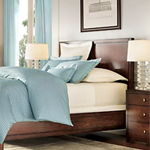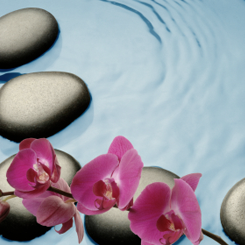Choosing the Right Colors
The Yin and Yang Colors and Feng Shui
Color is a very important part of feng shui. It is one of the easiest ways to shift the energy in your space with Feng Shui. It represents Ying and Yang. Each color is an expression of one of the Five Feng Shui Elements: Fire, Earth, Metal, Water, and Wood. Choose the Feng Shui colors according to the energy you need and bring them into your space with the wall color, art, photography, or various decor items. Color is like music, nourishing and uplifting, and the more colors you harmoniously absorb throughout the day, the higher your sense of well-being is.
Yin Colors & Feng Shui
Yin colors according to Feng Shui are the colors that bring about healing and relaxation. The relation between colors and Feng Shui can be better understood by taking the example of some colors as given below.
Blue: associated with the calm and soothing water energy as well as create a feeling of peace and trust. It reflects love as it heals and relaxes. It helps in meditation and creative endeavors. Blue can slow the heart and breathing rates and lower blood pressure. It is the color of the sea and sky, thus it's associated with adventure and exploration. Light blue signifies expansion and growth. Darker blue evokes the energy of deep calm and serenity, intellect and wisdom.
Green: the feng shui color of renewal, fresh energy, action, decisiveness and new beginnings. It can motivate internal change. Green color is very nourishing to your health, as it calms your nerves and balances your whole body by bringing healing feng shui vibrations from Mother Nature.
Turquoise: a blue-green combo, evokes the qualities of wood and water. It has both the contemplative qualities of blue and the life of green, making it a great choice for spaces that allow movement and growth.
Black: symbolizes money and income - black is great for careers, especially when combined with metal. It is the Feng Shui color of emotional protection and power. Black color is full of the feng shui energy of mystery and sophistication; it holds the energy of power and protection. The color of night, deep waters and universal void, feng shui use of color black adds depth, strength and definition to any space.
Purple: the color that lies at the end of the spectrum, has a great significance in Feng Shui. The color is excellent for physical and mental healing and Feng Shui associates it with spiritual awareness. Color Purple should be used with moderation. It is a very strong, high vibration color, the color of connection to the spiritual realms (7th chakra). Purple is a very high vibration color and the feng shui advice is to use it sparingly.
Lavender: a mix of the qualities of blue and purple, can evoke a sense of calm, spirituality, contemplation and quiet. Use lavender to minimize high activity, calm a stressful situation or create a special spiritual space. Lavender is best not used in spaces where conversation or high activity is encouraged.
Pink: the universal color of Love, which makes it a perfect feng shui color to soothe the energy. Its gentle and delicate feng shui vibrations have a proven soothing effect on one's behavior. You could almost say that, as a feng shui color, Pink literally soothes the heart and fills it with love. The widest use of Pink color in feng shui is in the Southwest area of one's space, as it is connected to Love & Marriage.
White: In Feng Shui the white color represents poise, confidence and purity. Because of its yin energy, Feng Shui uses this color mostly in combination with gold or silver to generate an calm atmosphere. White is the color that belongs to the feng shui element of Metal. Its feng shui energy is crisp, clear, clean and fresh. White is the color of beginnings, as well as clear endings.
Gray: color belonging to the element of Metal and it is best used in the West (Creativity & Children), Northwest (Helpful People & Blessings) or North (Career & Path in Life). Warm, silvery Gray color can bring a beautiful, clear and centering feng shui energy into your room. Avoid the feng shui use of color gray in big proportions in any of your bedrooms - either your own, your children's, or the older parents' bedroom.
Yang Colors and Feng Shui
Yang colors according to Feng Shui belong to tend to be fire and wood elements. Feng Shui believes that these are the colors that provide you the enthusiasm or the positive energy required to do something or be motivated. The description that Feng Shui provides for each color is given below to help you in using them for your advantage.
Red: associated with fire, supports life energy. It increases heart rate, respiration and blood pressure as well as promotes activity and alleviate depression. It’s the color of courage and love. It's hot, passionate and celebratory. Decorating red always signifies richness and luxury. If used too much, it can bring restlessness, bursts of anger and overstimulation. Bring red in your decor with details and accessories, rather than with furnishings or wall color.
Yellow: represents sunbeams, warmth, motion, cheerfulness and friendliness. It is associated with earth energy, representing Mother Earth. It is the most enchanting of all colors. It can infuse with hope,increase self-esteem, create a sense of stability, nurture, clarify and elevate mental activity and strengthen the overall well-being. However, exposure to large amounts of intense yellow can cause anxiety.
Orange: strengthens your concentration and is the color of organization. You might use this color when your creative well runs dry. Orange color in Feng Shui is used to give you a sense of purpose. Orange is often called the "social" color, as it creates the feng shui energy to promote lively conversations and good times in your home.
Salmon: a combo of yellow/orange and red/orange, is a unique balance of earth and fire elements that’s quite harmonious. Use salmon to call attention to the heart of a space, create a sense of abundance and encourage conversation.














